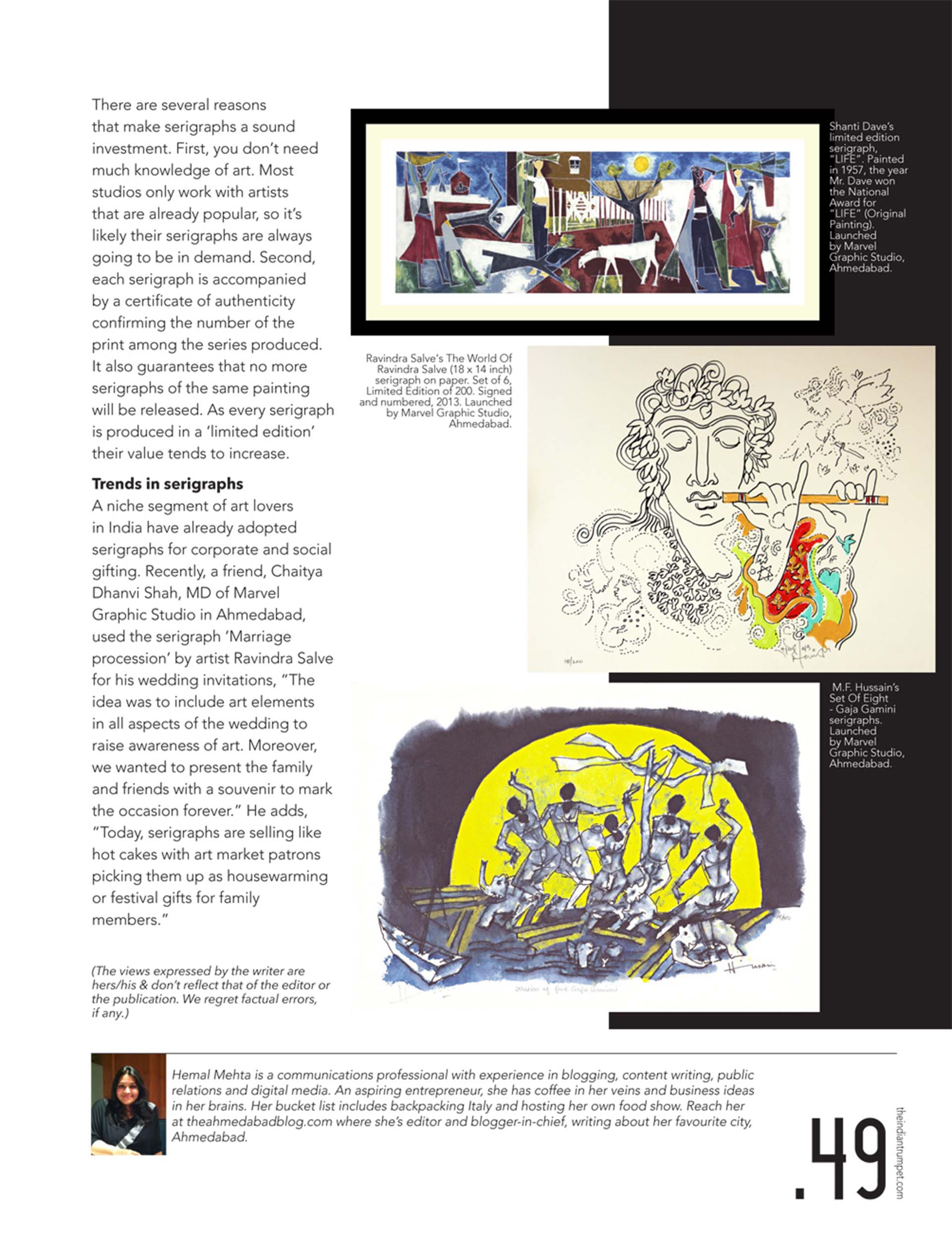Serigraphs, a fine investment
ART JUST GOT AFFORDABLE. ASPIRING COLLECTORS
CAN NOW ADORN THEIR WALLS WITH SERIGRAPHS,
QUALITY RENDITIONS OF ORIGINAL WORKS.
words HEMAL MEHTA
As a young art lover, owning art pieces by M. F.
Hussain, Jehangir Sabavala and Syed Haider Raza
seems nothing short of a dream to me. Investing in
Indian art is definitely a rich man’s game, especially
when spectacular works are auctioned at high profile
events. Moreover, a developed awareness of the art
world is required to determine a painting’s true value.
If you’re a budding art enthusiast or investor planning
your own collection, serigraphs are a smart way
forward. Here are ideas to help get you started.
Understanding the roots of serigraphy
A serigraph is essentially a rendition of an original
artwork achieved through the silk screen-printing
process. ‘Seri’ is the Latin word for silk and ‘graphos’
means ‘drawn’ in Greek, hence ‘serigraph’: drawn
through silk. Traditionally, stencils have been popular
worldwide to decorate fabrics, scriptures, robes and
artifacts. In the 20th century artistic screen-printing
took definitive shape and the art of serigraphy was
born.
The artist and his artwork
Even though a serigraph is a screen print for artistic
purposes, the artist is closely associated with the
process. Consulted at the outset, the artist may wish
to make changes to the original piece before the
serigraphy begins. They also decide how many prints
should be made (a number usually ranging between
30 and 200): the fewer the prints, the greater their
value. The printing technique is highly elaborate. It
begins with breaking the image down into separate
colours. A fine mesh silk screen is stretched tight on
a frame made from wood or aluminum and separate
inks are forced through it. The work is complete
once all the colours are printed. The entire process
is conducted under the artist’s personal supervision
and on completion, they sign, authenticate and
number every piece. Good studios prefer to print
onto museum quality paper so the serigraphs don’t
deteriorate and lose their value.
Serigraphs for investment
An original artwork by a famous artist will begin at a
few lakh rupees. In contrast the serigraph can cost
anywhere between `30,000 to `150,000: on average
only 5% of the original.
Art publisher Lavesh Jagasia of The Serigraph Studio
explains, “When a serigraph is released for the first
time, the first ten pieces are sold at a base price.
Once those are sold, the next set of prints will be sold
at a higher price. Once the limited edition serigraphs
of a particular artist are sold out, a secondary market
opens up that brings an appreciation or upswing for
that particular serigraph.”
There are several reasons that make serigraphs a sound
investment. First, you don’t need much knowledge of art.
Most studios only work with artists that are already popular,
so it’s likely their serigraphs are always going to be in
demand. Second, each serigraph is accompanied by a
certificate of authenticity confirming the number of the
print among the series produced. It also guarantees that no
more serigraphs of the same painting will be released. As
every serigraph is produced in a ‘limited edition’ their value
tends to increase.
Trends in serigraphs
A niche segment of art lovers in India have already adopted
serigraphs for corporate and social gifting. Recently, a friend,
Chaitya Dhanvi Shah, MD of Marvel Graphic Studio in Ahmedabad,
used the serigraph ‘Marriage procession’ by artist Ravindra Salve
for his wedding invitations, “The idea was to include art elements
in all aspects of the wedding to raise awareness of art. Moreover,
we wanted to present the family and friends with a souvenir to mark
the occasion forever.” He adds, “Today, serigraphs are selling like
hot cakes with art market patrons picking them up as housewarming
or festival gifts for family members.”
Where to buy?
Lavesh Jagasia’s ‘The Serigraph Studio’ (serigraphstudio.
com) promotes contemporary Indian serigraphs – signed,
limited editions by renowned senior artists such as S.
H. Raza, Ram Kumar, Jogen Chowdhary and Jehangir
Sabavala. But if you’re looking for M. F. Hussain’s serigraphs
in particular, check out Marvel Art Gallery (marvelartgallery.
com), which hosts an impressive range of his serigraphs
including Iqbal, Gajagamini, Asthavinayak, the Taj Series
and Mahabharat portfolio.









